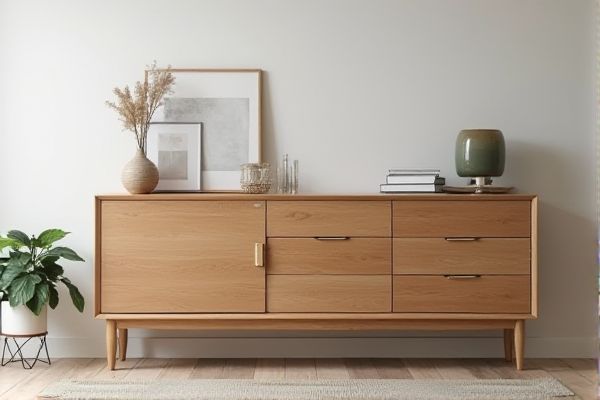
A sideboard with drawers offers organized storage space perfect for keeping utensils, linens, or small items neatly tucked away, while a sideboard without drawers emphasizes open or shelf storage that is ideal for displaying decorative pieces or larger items. Discover which style suits Your needs best by exploring the detailed comparison in this article.
Table of Comparison
| Feature | Sideboard with Drawers | Sideboard without Drawers |
|---|---|---|
| Storage Type | Multiple drawers for small items | Open shelves or cabinets for larger items |
| Organization | Enhanced organization with compartments | Less compartmentalization, more open space |
| Accessibility | Easy access to frequently used items | Items may be less accessible or visible |
| Design Aesthetic | Sleek, structured look | Simpler, minimalist style |
| Maintenance | Drawers require occasional cleaning & upkeep | Less maintenance, easier to clean surfaces |
| Use Cases | Ideal for storing cutlery, linens, or office supplies | Best for displaying decor or bulky items |
| Price Range | Typically higher due to complexity | Generally more affordable |
Introduction to Sideboards: With Drawers vs Without
Sideboards with drawers offer organized storage solutions ideal for keeping cutlery, napkins, and small household items neatly tucked away, enhancing both functionality and accessibility. In contrast, sideboards without drawers often feature open shelving or cabinet doors, providing versatile space for larger items like dishes, serving platters, or decorative pieces, emphasizing style and openness. Choosing between the two depends on specific storage needs and aesthetic preferences, balancing convenience with design.
Key Differences Between Drawer and Drawerless Sideboards
Sideboards with drawers provide organized storage for smaller items like cutlery, linens, and utensils, enhancing accessibility and reducing clutter in dining or living areas. Drawerless sideboards offer larger, open cabinet spaces better suited for storing bulky items such as serving dishes, trays, or glassware, promoting a minimalist and streamlined appearance. Choosing between the two depends on storage needs--drawers optimize compartmentalized organization, while drawerless designs maximize open storage capacity for larger objects.
Storage Capacity: Drawers vs Open Shelves
Sideboards with drawers offer enhanced storage capacity by providing enclosed compartments ideal for organizing smaller items and keeping clutter out of sight. In contrast, sideboards without drawers rely on open shelves, which are better suited for displaying decorative pieces but provide less secure storage for miscellaneous belongings. Your choice depends on whether you prioritize concealed storage or open display space in your living area.
Organization and Accessibility Comparison
Sideboards with drawers offer enhanced organization by providing specific compartments for smaller items, making it easier for you to categorize and access belongings quickly. In contrast, sideboards without drawers rely on open shelves or cabinets, which may limit accessibility for smaller objects but provide more flexible storage for larger items. Choosing a sideboard with drawers improves the separation of utensils, linens, or accessories, while models without drawers prioritize spacious storage versatility.
Design and Aesthetic Considerations
Sideboards with drawers offer organized storage that maintains a clean, streamlined look by concealing clutter, enhancing minimalist or modern interior designs. Sideboards without drawers often emphasize open shelving or cabinet doors, creating a more airy, spacious feel ideal for displaying decorative items and contributing to rustic or traditional aesthetics. Choosing between the two depends on whether the priority is functional storage with a polished appearance or an open, display-centric design that complements the room's overall style.
Best Use Cases for Sideboards with Drawers
Sideboards with drawers are ideal for organizing smaller items like cutlery, linens, and dining accessories, making them perfect for dining rooms where easy access and clutter reduction are priorities. They work well in living rooms or offices to store stationery, remote controls, or miscellaneous items, keeping surfaces clean and spaces tidy. Your choice of a sideboard with drawers enhances functionality by combining storage versatility with easy categorization and retrieval of everyday essentials.
When to Choose a Drawerless Sideboard
A drawerless sideboard is ideal for displaying decorative items or storing large, bulky objects that do not fit well in drawers, such as platters and serving bowls. Choose a drawerless model when you prefer easy access to open shelving or ample cabinet space rather than segmented storage compartments. This design enhances minimalist aesthetics and simplifies organization for items frequently used or showcased.
Maintenance and Cleaning Differences
Sideboards with drawers require more detailed maintenance to clean inside the compartments, where dust and debris can accumulate, demanding regular vacuuming or wiping with a microfiber cloth. Sideboards without drawers offer simpler cleaning, as open shelves or flat surfaces allow for quick dusting and fewer hidden spaces. Choosing a sideboard depends on cleaning preferences, with drawers offering organized storage but increased upkeep, while non-drawer designs provide ease of maintenance and quicker dust removal.
Price Comparison: With Drawers vs Without
Sideboards with drawers typically have higher price points than those without due to the added materials, craftsmanship, and hardware. The inclusion of drawers increases manufacturing complexity, which directly impacts cost. Budget-conscious buyers may find simpler, drawerless sideboards more affordable while sacrificing storage versatility.
How to Choose the Right Sideboard for Your Space
When choosing the right sideboard for your space, consider the need for storage versatility; sideboards with drawers offer organized compartments ideal for utensils and small items, while those without drawers provide more open shelves or cabinets for larger items. Measure your room's layout and storage requirements to ensure the sideboard's dimensions and features complement your existing furniture and usage needs. Evaluate your daily use, prioritizing drawers for easy access and clutter management or opting for drawerless models when showcasing decorative pieces and optimizing spaciousness matters most.
 homyna.com
homyna.com